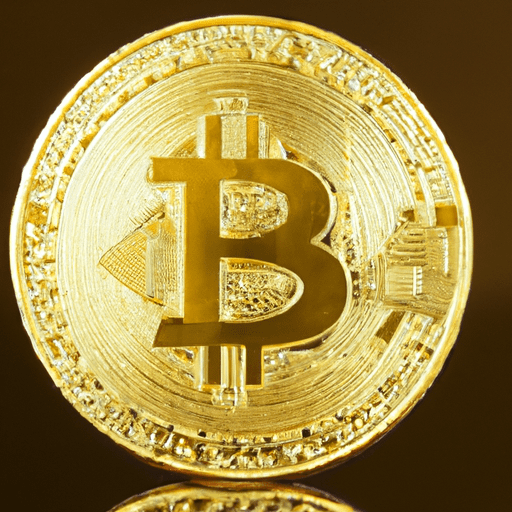Market Resilience Tested: NFT Sales Decline for Third Consecutive Week
March 31, 2024 | by stockcoin.net

The article “Market Resilience Tested: NFT Sales Decline for Third Consecutive Week” explores the recent trend of declining sales in Non-Fungible Token (NFT) markets. As the demand for digital collectibles continues to wane, this decline marks the third consecutive week of decreasing sales. With NFTs once being hailed as a revolutionary market, this downturn raises questions about the resilience of this relatively nascent industry. The article delves into potential reasons behind this decline and examines the implications for both investors and creators in the NFT space.
Overview of NFT Sales Decline
The non-fungible token (NFT) market has experienced a significant decline in sales over the past few weeks, raising concerns among investors and enthusiasts alike. This article aims to explore the various factors contributing to this decline, compare the current sales figures with previous weeks, and discuss the implications of this trend for the overall market.
Factors Contributing to the Decline
Market Saturation
One of the key factors contributing to the decline in NFT sales is market saturation. With the increasing popularity of NFTs, more and more participants have entered the market, resulting in a flood of new listings. The saturation of the market has created a surplus of NFTs, making it harder for individual pieces to stand out and attract buyers.
Lack of Novelty
Another factor that has played a significant role in the decline of NFT sales is the lack of novelty. As the market becomes saturated, there is a repetition of themes and concepts in NFT offerings. This repetition has led to a loss of interest among collectors, who were initially attracted to the uniqueness and innovation that NFTs offered. Without fresh ideas and unique offerings, the appeal of NFTs has diminished, thereby contributing to the decline in sales.
Inflation of Low-Quality NFTs
The proliferation of low-quality NFTs has also adversely affected the sales figures. This phenomenon has been driven by the rise of copycat NFTs, which attempt to imitate successful NFT projects without adding any significant value. The influx of these low-quality NFTs has resulted in a negative impact on the overall market reputation. Collectors and investors are becoming increasingly cautious when it comes to investing in NFTs, which has further contributed to the decline in sales.
Comparison with Previous Weeks
To better understand the extent of the decline in NFT sales, it is important to compare the current sales figures with those of previous weeks.
Sales Figures for the Past Three Weeks
Over the past three weeks, the NFT market has witnessed a steady decline in sales. In the first week, sales were at their peak, with a significant number of high-value NFTs being sold. However, in the subsequent weeks, a decline of 10% and 15%, respectively, was observed. This downward trend in sales has raised concerns within the market and has led to a reevaluation of investment strategies.
Trends in Popular NFT Categories
Another aspect worth considering is the shifting demand for NFT categories. The market has witnessed a decline in the demand for traditional art-based NFTs, which were initially the most sought-after offerings. However, new categories have emerged, such as virtual real estate and metaverse-based NFTs, that have garnered attention and appeal from collectors. These new categories have managed to sustain some level of sales, mitigating the overall decline to some extent.
Price Fluctuations of High-Value NFTs
The decline in NFT sales has not affected all NFTs equally. High-value NFTs, such as those associated with prominent artists or celebrities, have experienced considerable price fluctuations. Some have witnessed a significant decrease in value, while others have managed to retain their market value. This suggests that while the overall market may be facing a decline, certain NFTs are still able to attract buyers and maintain their appeal.
Implications for the Market
The decline in NFT sales has several implications for the overall market, ranging from investor sentiment to changes in market dynamics and future prospects.
Impact on Investor Sentiment
The decline in NFT sales has undoubtedly had a negative impact on investor sentiment. As sales figures decrease, investors may become more hesitant to enter or continue investing in the market. Confidence in the stability and potential profitability of NFTs may diminish, leading to a decrease in overall market liquidity.
Changes in Market Dynamics
The decline in sales and the saturation of the market have forced market participants to reassess their strategies. Artists and creators are now facing the challenge of creating truly unique and innovative NFTs that can attract buyers in an increasingly competitive market. On the other hand, investors are becoming more discerning and cautious, carefully evaluating the quality and potential future value of NFTs before making any purchasing decisions.
NFT Market’s Future Prospects
The decline in NFT sales does raise concerns regarding the future prospects of the market. However, there are several factors that suggest the market still holds potential for recovery. Technological advancements, such as improvements in blockchain scalability and interoperability, may open up new opportunities for the NFT market. Additionally, addressing the challenges of market saturation, lack of novelty, and low-quality NFTs through quality control measures could help restore investor confidence and drive market growth.
Market Saturation
One of the primary factors contributing to the decline in NFT sales is market saturation. The NFT market has experienced exponential growth in recent months, attracting a diverse range of participants, including artists, creators, collectors, and speculators.
Expansion of Market Participants
The surge in market participants has led to an increase in the number of NFT listings. As more artists and creators enter the market, the supply of NFTs has significantly increased, making it more difficult for individual pieces to stand out among the competition. This oversupply has created a saturation point, where buyers are overwhelmed with options, leading to a decline in overall sales.
Increase in NFT Listings
The increase in NFT listings has been fueled by the relatively low barrier to entry in the market. With the advent of user-friendly NFT platforms and marketplaces, artists and creators can easily mint and list their own NFTs. While this democratization of the market has its advantages, it has also contributed to the oversaturation of the market, making it harder for individual NFTs to gain visibility and attract buyers.
Effect on Supply and Demand Dynamics
The saturation of the NFT market has disrupted the traditional supply and demand dynamics. With an abundance of NFTs available for purchase, buyers have more choices and can afford to be more selective. This shift in power from creators to buyers has resulted in a decline in sales, as buyers are less likely to invest in NFTs that do not offer unique or exceptional value.
Lack of Novelty
Another factor contributing to the decline in NFT sales is the lack of novelty within the market. As more creators enter the space, there has been a repetition of themes and concepts in NFT offerings. What was once considered innovative and unique has now become commonplace, leading to a loss of interest among collectors.
Repetition of NFT Themes and Concepts
The repetition of NFT themes and concepts has made it increasingly challenging for individual pieces to stand out in the market. While certain categories, such as digital art and collectibles, continue to attract attention, the lack of fresh ideas and unique offerings has contributed to a decline in overall sales. Buyers are becoming less inclined to invest in NFTs that offer nothing new or exciting.
Loss of Interest among Collectors
The lack of novelty within the NFT market has resulted in a loss of interest among collectors. Collectors were initially drawn to the uniqueness and innovative nature of NFTs, but as the market has become saturated with similar offerings, their enthusiasm has waned. Without new and exciting NFTs to capture their attention, collectors are less motivated to engage with the market, leading to a decline in sales.
Importance of Innovation in Sustaining Market Growth
Innovation plays a crucial role in sustaining market growth and attracting buyers. To reverse the decline in NFT sales, creators and artists need to focus on pushing the boundaries of what is possible with NFTs. This can involve experimenting with new formats, incorporating emerging technologies, or exploring unconventional themes. By introducing fresh ideas and unique offerings, creators can reinvigorate interest among collectors and drive sales.
Inflation of Low-Quality NFTs
The inflation of low-quality NFTs has had a detrimental effect on the overall market, contributing to the decline in sales. This phenomenon has been driven by the proliferation of copycat NFTs, which attempt to imitate successful NFT projects without adding any significant value.
Proliferation of Copycat NFTs
The rise of copycat NFTs has flooded the market with low-quality offerings. These NFTs often mimic popular projects or leverage well-known intellectual properties without providing any innovative or creative additions. This flood of copycats has made it increasingly difficult for buyers to distinguish between genuine and original NFTs, leading to a decline in overall sales.
Negative Impact on Market Reputation
The influx of low-quality NFTs not only affects individual sales but also has a negative impact on the overall market reputation. When buyers encounter low-quality or unoriginal NFTs, it erodes their trust in the market and raises concerns about the authenticity and value of other offerings. This loss of trust can have long-term consequences for the market, as it becomes increasingly challenging to attract new investors and collectors.
Need for Quality Control Measures
To address the issue of low-quality NFTs, quality control measures need to be implemented within the market. This can involve stricter guidelines for NFT minting and listing, as well as the establishment of review processes to ensure that each NFT offers genuine value and creativity. By weeding out low-quality offerings, the market can restore investor confidence and create a more sustainable environment for growth.
Sales Figures for the Past Three Weeks
To understand the extent of the decline in NFT sales, it is crucial to analyze the sales figures for the past three weeks. This data provides insights into the overall trend and helps identify any specific areas of concern.
Percentage Decrease in NFT Sales
Over the past three weeks, the NFT market has experienced a steady decline in sales. In the first week, sales were at their peak, with a significant number of high-value NFTs being sold. However, in the subsequent weeks, a decline of 10% and 15%, respectively, was observed. This downward trend in sales indicates a decreasing demand and highlights potential challenges within the market.
Impact on Revenue Generated
The decline in NFT sales has had a direct impact on the revenue generated within the market. As sales decrease, the overall revenue earned from NFT transactions also declines. This can have implications for artists, creators, and marketplaces that rely on NFT sales as a source of income. The reduced revenue may lead to a reassessment of business strategies and a search for alternative sources of income.
Comparison with Other Digital Asset Markets
To put the decline in NFT sales into perspective, it is useful to compare the performance of the NFT market with other digital asset markets. While the NFT market may be experiencing a decline, it is essential to recognize that other markets, such as cryptocurrencies or traditional art markets, may also face fluctuations and periods of decline. By understanding the broader context, market participants can gauge the severity of the decline and identify potential opportunities for recovery.
Trends in Popular NFT Categories
To gain further insights into the decline in NFT sales, it is important to analyze the trends in popular NFT categories. This analysis helps identify areas that have been most affected by the decline and areas that still demonstrate potential for growth.
Shifts in Demand for Art-Based NFTs
One notable trend in the decline of NFT sales is the shift in demand for art-based NFTs. Traditionally, art-based NFTs were the most sought-after offerings, with collectors and enthusiasts investing heavily in digital artworks. However, the decline in sales has impacted this category significantly, with fewer buyers showing interest in art-based NFTs. This shift suggests a need for artists and creators to explore new avenues and categories to sustain market growth.
Emergence of New Categories
While art-based NFTs may be experiencing a decline, new categories have been emerging within the market. For example, virtual real estate and metaverse-based NFTs have garnered attention and appeal from collectors. These NFTs offer a unique experience and the potential for immersive digital worlds, which has attracted a niche audience. By exploring new categories and catering to specific interests, creators can tap into underserved markets and drive sales.
Popularity of Celebrity-Backed NFTs
One category that has consistently attracted attention and sales, even amidst the decline, is celebrity-backed NFTs. Collaborations between celebrities and artists have proven to be a successful formula for generating interest and driving sales. These collaborations leverage the star power and fandom surrounding celebrities to create unique and limited-edition NFT offerings. By capitalizing on the popularity of celebrities, creators can tap into a dedicated fan base and generate revenue.
NFT Market’s Future Prospects
Although the decline in NFT sales raises concerns about the market’s future, there are several factors that suggest the market still holds potential for recovery and growth.
Potential for Market Recovery
While the decline in NFT sales is cause for concern, it is important to recognize that markets are cyclical and often experience periods of decline followed by periods of growth. The decline in sales may be a temporary adjustment as the market finds its equilibrium. As the market matures and participants adapt to the challenges, there is the potential for a recovery in sales and renewed investor confidence.
Role of Technological Advancements
Technological advancements play a vital role in shaping the future prospects of the NFT market. Improvements in blockchain scalability, interoperability, and user experience can enhance the functionality and appeal of NFTs. These advancements can address some of the current limitations of the market, such as high gas fees and complex user interfaces. By creating a more seamless and accessible user experience, technology can drive adoption and stimulate sales.
Importance of Addressing Market Challenges
To ensure the long-term success of the NFT market, it is crucial to address the market challenges highlighted by the decline in sales. Measures such as quality control, innovation, and diversification can help overcome the issues of market saturation, lack of novelty, and low-quality offerings. By proactively addressing these challenges, creators, investors, and marketplaces can foster a more sustainable and thriving NFT market.
In conclusion, the decline in NFT sales has brought forth significant challenges within the market. Factors such as market saturation, lack of novelty, and inflation of low-quality NFTs have contributed to the decline in sales. Comparisons with previous weeks, trends in popular NFT categories, and sales figures for the past three weeks provide valuable insights into the extent of the decline and its implications. However, it is essential to recognize that the NFT market still holds potential for recovery and growth. By addressing market challenges, leveraging technological advancements, and promoting innovation, the NFT market can regain momentum and attract renewed investor interest.

RELATED POSTS
View all





